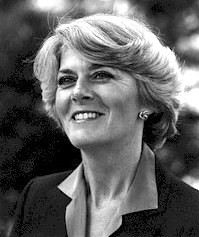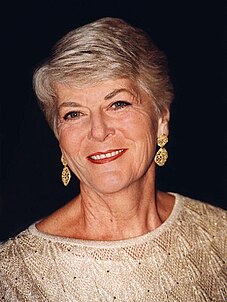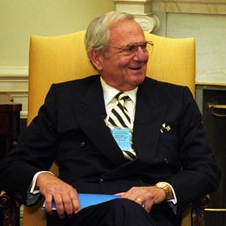
The 1984 United States presidential election was the 50th quadrennial presidential election. It was held on Tuesday, November 6, 1984. Incumbent Republican President Ronald Reagan defeated former Vice President Walter Mondale, the Democratic candidate.

Walter Frederick "Fritz" Mondale is an American politician, diplomat and lawyer who served as the 42nd vice president of the United States from 1977 to 1981. A United States senator from Minnesota (1964–1976), he was the Democratic Party's nominee in the United States presidential election of 1984, but lost to Ronald Reagan in an Electoral College landslide. Reagan won 49 states while Mondale carried his home state of Minnesota and District of Columbia. He became the oldest-living former U.S. vice president after the death of George H. W. Bush in 2018.

The 1984 National Convention of the U.S. Democratic Party was held at the Moscone Center in San Francisco, California from July 16 to July 19, 1984, to select candidates for the 1984 United States presidential election. Former Vice President Walter Mondale was nominated for President and Representative Geraldine Ferraro of New York was nominated for Vice President. Ferraro became the first woman to be nominated by either major party for the Presidency or Vice-Presidency. In another first, the 1984 Democratic Convention was chaired by the female governor of Kentucky, Martha Layne Collins. The Democratic National Committee Chairman at the time, Charles T. Manatt, led the convention.

The 1984 Democratic presidential primaries were the selection process by which voters of the Democratic Party chose its nominee for President of the United States in the 1984 U.S. presidential election. Former Vice President Walter Mondale was selected as the nominee through a series of primary elections and caucuses culminating in the 1984 Democratic National Convention held from July 16 to July 19, 1984, in San Francisco, California.

The 1984 United States elections was held on November 6, and elected the members of the 99th United States Congress. The Republicans won a landslide victory in the presidential election, picked up seats in the House, and successfully defended their Senate majority.

The 1984 United States presidential election in Oregon took place on November 6, 1984. All fifty states and the District of Columbia were part of the 1984 United States presidential election. Oregon voters chose seven electors to the Electoral College, which selected the president and vice president of the United States.

The 1984 United States presidential election in Illinois took place on November 6, 1984. All 50 states and the District of Columbia, were part of the 1984 United States presidential election. Illinois voters chose 24 electors to the Electoral College, which selected the president and vice president of the United States.

The 1984 United States presidential election in Ohio took place on November 6, 1984. All 50 states and the District of Columbia, were part of the 1984 United States presidential election. Ohio voters chose 23 electors to the Electoral College, which selected the president and vice president of the United States.

The 1984 United States presidential election in Kentucky took place on November 6, 1984. All 50 states and the District of Columbia, were part of the 1984 United States presidential election. Kentucky voters chose 9 electors to the Electoral College, which selected the president and vice president of the United States.

The 1984 United States presidential election in Virginia took place on November 6, 1984. All fifty states and the District of Columbia, were part of the 1984 United States presidential election. Virginia voters chose twelve electors to the Electoral College, which selected the president and vice president of the United States.

The 1984 United States presidential election in Rhode Island took place on November 6, 1984. All 50 states and the District of Columbia, were part of the 1984 United States presidential election. Rhode Island voters chose 4 electors to the Electoral College, which selected the president and vice president of the United States.
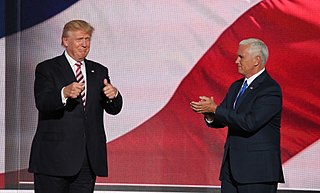
This article lists potential candidates for the Republican nomination for Vice President of the United States in the 2016 United States presidential election. Businessman Donald Trump of New York, the 2016 Republican nominee for President of the United States, considered several prominent Republicans and other individuals before selecting Governor Mike Pence of Indiana as his running mate on July 15, 2016. Pence formally won the vice presidential nomination on July 19, 2016, at the 2016 Republican National Convention. As the Trump-Pence ticket won the 2016 presidential election, Pence became Vice President of the United States on January 20, 2017.

This article lists those who were potential candidates for the Democratic nomination for Vice President of the United States in the 1976 election. Former Georgia Governor Jimmy Carter won the 1976 Democratic nomination for President of the United States, and chose Minnesota Senator Walter Mondale as his running mate. According to Joel Goldstein, a legal professor and the author of several works on the vice presidency, 1976 marked the beginning of the modern vice presidential selection process, with candidates undergoing extensive vetting. Carter thought that the vice president could be an important asset for a president, and Mondale became a major part of Carter's campaign. The choice of Mondale helped Carter, a Southern "outsider" with little experience in Washington, rally the Democratic base to his candidacy. The Carter-Mondale ticket defeated the Ford-Dole ticket in the 1976 election.

This article lists those who were potential candidates for the Democratic nomination for Vice President of the United States in the 1972 election. Coming into the 1972 Democratic National Convention, South Dakota Senator George McGovern had the delegate lead, but did not have the presidential nomination locked up. After winning the Democratic nomination for president on July 13, McGovern looked for a running mate. McGovern's first choice for vice president was Ted Kennedy, but Kennedy refused to join the ticket; Minnesota Senator Walter Mondale, Wisconsin Senator Gaylord Nelson, and Connecticut Senator Abraham A. Ribicoff also declined. McGovern offered the position to Missouri Senator Thomas Eagleton, who appealed to labor groups and Catholics, two groups that McGovern had alienated during the primary campaign. The ticket of McGovern and Eagleton was nominated by the 1972 Democratic National Convention. Following the convention, it was revealed that Eagleton had received treatment for depression. Though McGovern considered keeping Eagleton on the ticket, he ultimately chose to replace Eagleton with former Ambassador Sargent Shriver. The McGovern-Shriver ticket lost the presidential election to the Nixon-Agnew ticket. After the controversy surrounding Eagleton, future campaigns spent much more time vetting vice presidential candidates.

This article lists those who were potential candidates for the Republican nomination for Vice President of the United States in the 1980 election. Former California Governor Ronald Reagan won the 1980 Republican nomination for President of the United States, and chose former Texas Representative George H. W. Bush as his running mate. Reagan had considered naming former president Gerald Ford as his running mate, but after Ford and Reagan were unable to agree to be on the same ticket, Reagan turned to Bush, his primary rival for the 1980 Republican nomination. Though Bush had criticized Reagan's policies, Reagan chose Bush to help unify the party, and Bush agreed to be on the ticket and to support Reagan's platform. The Reagan-Bush ticket defeated the incumbent Democratic Carter-Mondale ticket, and in 1984 won re-election defeating the Mondale-Ferraro ticket. Bush was later elected president in his own right in 1988.
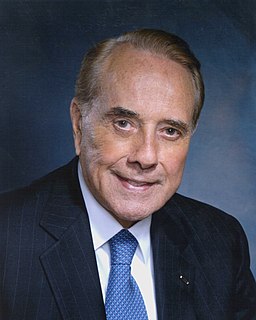
This article lists those who were potential candidates for the Republican nomination for Vice President of the United States in the 1976 election. At the 1976 Republican National Convention, incumbent President Gerald Ford narrowly won the presidential nomination over former California Governor Ronald Reagan. Ford had decided not to pick Vice President Nelson Rockefeller as his running mate, due to Rockefeller's unpopularity with the right wing of the Republican Party. Ford chose Kansas Senator Bob Dole as his running mate, instead. Dole was acceptable to the conservative wing of the party, and Ford hoped that Dole would help the ticket win the western states and the agricultural vote. The Ford-Dole ticket lost the general election to the Carter-Mondale ticket. Though he did not win the nomination, Reagan announced before the convention that he would pick Senator Richard Schweiker of Pennsylvania as his running mate.
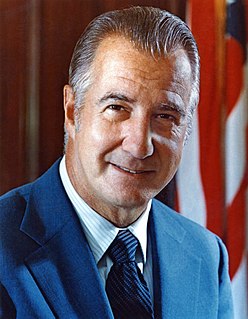
This article lists those who were potential candidates for the Republican nomination for Vice President of the United States in the 1968 election. After winning the Republican presidential nomination at the 1968 Republican National Convention, former Vice President Richard Nixon convened a series of meetings with close advisers and party leaders such as Strom Thurmond in order to choose his running mate. Nixon ultimately asked the convention to nominate Maryland Governor Spiro Agnew as his running mate. By a large margin, Agnew won the vice presidential nomination on the first ballot over Michigan Governor George W. Romney, who was supported by a faction of liberal Republicans. Nixon chose Agnew because he wanted a centrist who was broadly acceptable to the party, had experience with domestic issues, and appealed to Southern voters. The Nixon-Agnew ticket defeated the Humphrey-Muskie ticket, and also won re-election in 1972, defeating the McGovern-Shriver ticket. However, Agnew was forced to resign as Vice President in 1973 due to a controversy regarding his personal taxes.

This article lists those who were potential candidates for the Democratic nomination for Vice President of the United States in the 1964 election. After the assassination of Democratic President John F. Kennedy in 1963, Vice President Lyndon B. Johnson ascended to the presidency. As the 25th Amendment had not yet been passed, there was no process for filling the office of vice president until the next election, and Speaker of the House John William McCormack was next-in-line for the presidency from November 1963 to January 1965. Johnson carefully considered his running mate for the 1964 election, and put up "trial balloons" in the media about possible running mates. Among those speculated at the time were Connecticut Senators Abraham Ribicoff and Thomas J. Dodd, Secretary of Defense Robert McNamara, New York Mayor Robert Wagner, California Governor Pat Brown, and Minnesota Senators Hubert Humphrey and Eugene McCarthy. Many Democrats also hoped for Attorney General Robert F. Kennedy, the brother of former President John F. Kennedy, but Johnson carefully maneuvered to keep Kennedy off the ticket due to personal enmity between the two. After an interview in the Oval Office, Johnson announced his choice of Humphrey, who provided geographic balance to the ticket and had been a key lieutenant for Johnson in the Senate, particularly in regards to the 1964 Civil Rights Act. Humphrey then easily won the vice presidential nomination on the first ballot at the 1964 Democratic National Convention. The Johnson-Humphrey ticket went on to beat the Goldwater-Miller ticket in the 1964 election. Humphrey later won the 1968 Democratic presidential nomination over McCarthy, but lost the election to Richard Nixon.
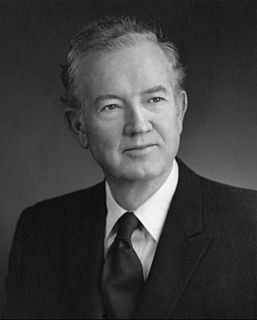
This article lists those who were potential candidates for the Democratic nomination for Vice President of the United States in the 1952 election. After winning the presidential nomination on the third ballot of the 1952 Democratic National Convention, Illinois Governor Adlai Stevenson consulted with Democratic Party leaders such as President Harry S. Truman and Speaker Sam Rayburn. Stevenson chose Alabama Senator John Sparkman, a Southern centrist, as his running mate. Sparkman won the vice presidential nomination on the first ballot as no serious rival tried to displace Stevenson's choice. However, many Northerners were not enthused with the choice of Sparkman due to Sparkman's stance on civil rights. During the 1952 convention, Sparkman, who had supported Senator Richard Russell for president, played a part in watering down the party's platform on civil rights. New York Representative Adam Clayton Powell Jr. and others walked out of the convention after the choice of Sparkman was announced. The Democratic ticket lost the 1952 election to the Republican ticket of Dwight D. Eisenhower and Richard Nixon.
The 1984 presidential campaign of Walter Mondale, a former Minnesota senator and Vice President of the United States, began on February 21, 1983, when Mondale announced that he was running for president in a speech at the Minnesota State Capitol. Mondale won the Democratic Party's presidential nomination after convincing Frank Lautenberg, a previously unpledged party delegate, to support him. Lautenberg's vote gave Mondale the 1,967 delegate votes needed to become the Democratic Party's nominee. Mondale lost the general election, held on November 6, 1984, to incumbent Republican President Ronald Reagan in a landslide.
